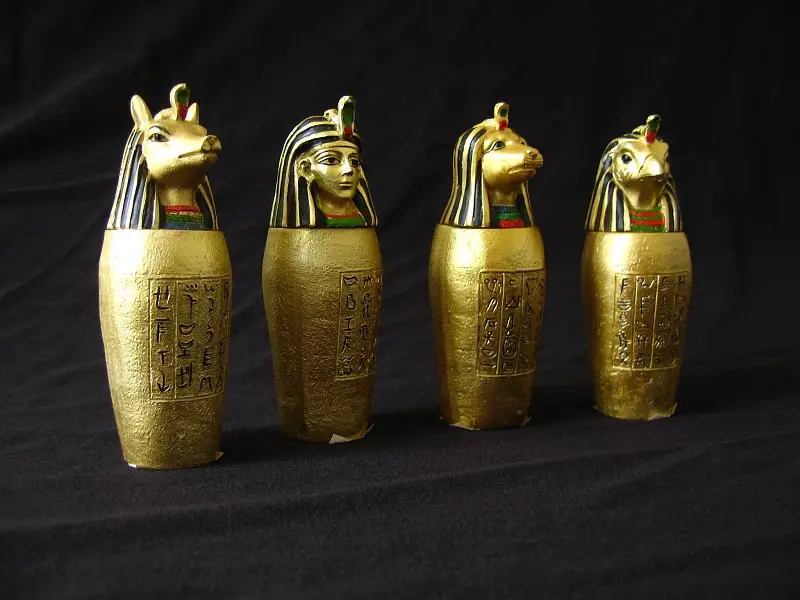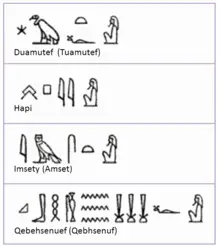Canopic Jars
Canopic jars were used in ancient Egyptian funerary practices to hold the organs of the deceased. These jars were typically made of stone or pottery and were decorated with the heads of the four sons of Horus: Imsety, Hapy, Duamutef, and Qebehsenuef.
The organs were removed during the mummification process and placed in the jars, which were then buried with the body. The use of canopic jars was an important part of Egyptian religious beliefs and customs surrounding death and the afterlife.
The ancient Egyptians had a strong religious belief that when a person died they would return to an ‘afterlife’ that was almost the same as the life they had when they were alive.
In their belief, the body needed to be preserved so that the person could return.
This is why the Egyptians created mummies.
The process required that not only the outside of the person’s body be mummified, but also all of the internal organs.
The four jars were:
- Imsety had a human head and carried and protected the liver.
- Qebehsenuf had a falcon’s head and carried and protected the intestines.
- Hapy had the head of a baboon and carried and protected the lungs.
- Duamatef had the head of a jackal and carried and protected the stomach.

Canopic Jars Facts for Kids
- Canopic jars were used by ancient Egyptians.
- They stored mummified remains’ internal organs.
- There are 4 jars, each with a unique lid.
- Lids were shaped like heads of 4 gods.
- The gods were Imsety, Duamutef, Hapi, Qebehsenuef.
- Imsety’s jar held the liver, he had a human head.
- Duamutef, with a jackal head, stored the stomach.
- Hapi’s baboon-headed jar held the lungs.
- Qebehsenuef, the falcon-headed god, stored intestines.
- Jars were often made of limestone, alabaster, or clay.
Ancient Egyptian Burial Customs
Canopic jars were vital in ancient Egyptian burial practices. During mummification, each organ removed – the liver, lungs, stomach, and intestines – was preserved in its own jar. More than storage, each jar was linked to a specific god, symbolizing protection for the organ inside.
Crafted with the head of its guardian deity, the jars were not just functional but were also spiritual symbols. Thus, Canopic jars demonstrate the Egyptians’ detailed preparations for their afterlife journey.
Mummification Process
Canopic jars were a fundamental part of the mummification process in Ancient Egypt. Embalmers removed organs from the body, preserved them, and placed them in Canopic jars. Each jar, linked to a specific god, stored a particular organ. The human-headed god Imsety’s jar held the liver, and Duamutef, the jackal-headed god, guarded the stomach.
The baboon-headed god Hapi’s jar contained the lungs, while Qebehsenuef, the falcon-headed god, kept the intestines safe. Once sealed, these jars were laid in the tomb alongside the mummy, securing the organs for the afterlife. This ritual signifies the importance Egyptians placed on preparation for eternity.
Ancient Egyptian Gods and Goddesses
Canopic jars demonstrate the connection between the physical and spiritual in ancient Egypt, particularly through the representation of gods. Each jar bore the head of a specific god, protecting a specific organ. The liver was guarded by the human-headed Imsety, the stomach by the jackal-headed Duamutef.
Hapi, shown with a baboon’s head, protected the lungs, while the falcon-headed Qebehsenuef watched over the intestines. These gods, known as the sons of Horus, underlined the importance of spirituality in Egyptian daily practices, including their burial customs.
Egyptian Tombs and Pyramids
Canopic jars shed light on burial practices in Egyptian tombs and pyramids. These jars, containing preserved organs, were important burial items placed alongside mummies. Found in both royal and non-royal tombs, they give us insights into the burial customs of various social classes. In significant sites like the Pyramids of Giza, these jars were often stored in dedicated chests, emphasizing their value. The presence of Canopic jars in these burial sites highlights the Egyptians’ detailed preparation for the afterlife.
Ancient Egyptian Artifacts
Canopic jars are important ancient Egyptian artifacts that shed light on funerary practices. Crafted from materials like alabaster or limestone, these jars were skillfully designed, each topped with a deity’s head. Not only practical, they’re also artistic, showing the craft level in ancient Egypt.
The jars’ design and material changes over time provide insights into evolving art styles and society. Hence, Canopic jars offer a direct connection to the past, reflecting the customs, beliefs, and aesthetics of the era.
The Book of the Dead
Canopic jars have a strong tie to the ‘Book of the Dead’, an ancient Egyptian guide to the afterlife. The jars, which stored mummified organs, are referred to in several spells in the book. They are linked to the four sons of Horus, believed to guard the organs.
Certain spells were said over the jars to summon this protection. This reveals the jars’ spiritual role, not just as organ containers, but as crucial elements for a successful journey to the afterlife, as described in the ‘Book of the Dead’.
Egyptian Funerary Texts
Canopic jars, featured in Egyptian funerary texts, were central to beliefs about death and the afterlife. These texts detail rituals and spells related to the jars’ purpose – preserving organs for the afterlife. Each jar was guarded by a son of Horus, invoked in the texts for protection.
The preparation and sealing of these jars, as outlined in the texts, underscore their critical role in burial rites. Funerary texts reveal that Canopic jars were sacred vessels within complex beliefs and rituals about death and rebirth.
What is inside Canopic jars?
Canopic jars were created to contain all of the organs, so that upon entering the afterlife, the person would be complete.
We might find the practice of preserving the internal organs and placing them in jars, a bit odd.
The ancient Egyptian religions were very specific about the way someone needed to be prepared so that they could enter the afterlife.
Each of the Canopic jars had a specific purpose and were designed to honor the four sons of Horus.
Horus was the Egyptian god of the sky and the contents of the Canopic jars would go along with the person as they passed through and entered the afterlife and protect the remains.


Canopic jars were highly decorated and the top of each jar was a kind of lid or ‘stopper’.
Each lid had a representation of the head of each of Horus’ four sons and contained a different organ.
They were put into a special chest that was placed in the tomb of the person that had died.
If there wasn’t a chest to put the jars into, they kept all four jars together and put them close to the mummy.

Egyptian religious belief
Part of the Egyptian religious belief was that as a person prepared to enter the afterlife, they would have to be tested to see if they had led a good life.
Their heart would be placed on a scale with a feather on the other side. If the feather was heavier than their heart, they could pass.
It was because of this belief that the heart was left in the body and not placed into a jar. They thought the mummified body needed the heart so that it could pass the test.
Strangely, the Egyptians didn’t think the brain was important.
They thought the center of the body and soul was the heart.
When they created a mummy, they destroyed the brain.

Symbol of Honor
The original Canopic jars were hollow and the internal organs were wrapped in linen along with their holy oils and placed inside the jars.
This process was thought to preserve the internal organs for all eternity.
As the Egyptians got better at making mummies, they would mummify the internal organs and put them back in the body of the person that had died and then complete the mummification.
They continued to put the four Canopic jars into the tomb, even though they were empty.
This was a symbol to honor the four sons of Horus and allow them to protect the person as they crossed over.

What are Canopic jars Made from?
The jars could be made of a number of different things” limestone, calcite or alabaster.
The Old Kingdom of Egypt was around 2686-2181 BC and during that time there was hardly ever any inscription or writing on the Canopic jars.
By the Middle Kingdom, 2025-1700 BC, they began to put writing on the jars.
It wasn’t until the Nineteenth Dynasty and later that they began to decorate each of the jars with the heads of the four sons of Horus.
Fun Facts about Canopic Jars
- There were four Canopic Jars.
- The Egyptians used them for safekeeping of particular human organs.
- They contained the stomach, intestines, lungs, and liver.
- Egyptian believed they would be needed in the afterlife.
- The jars were placed in the tombs with the bodies.



